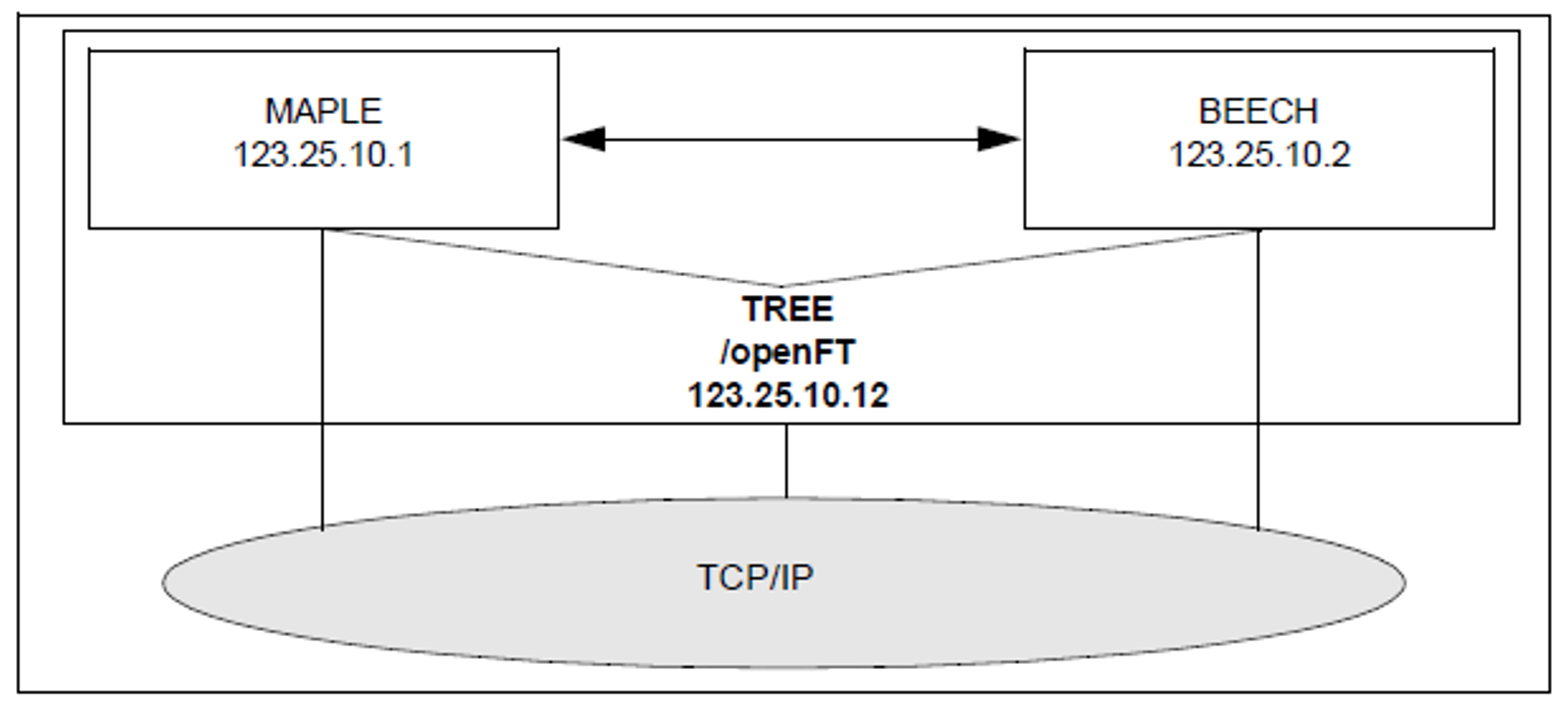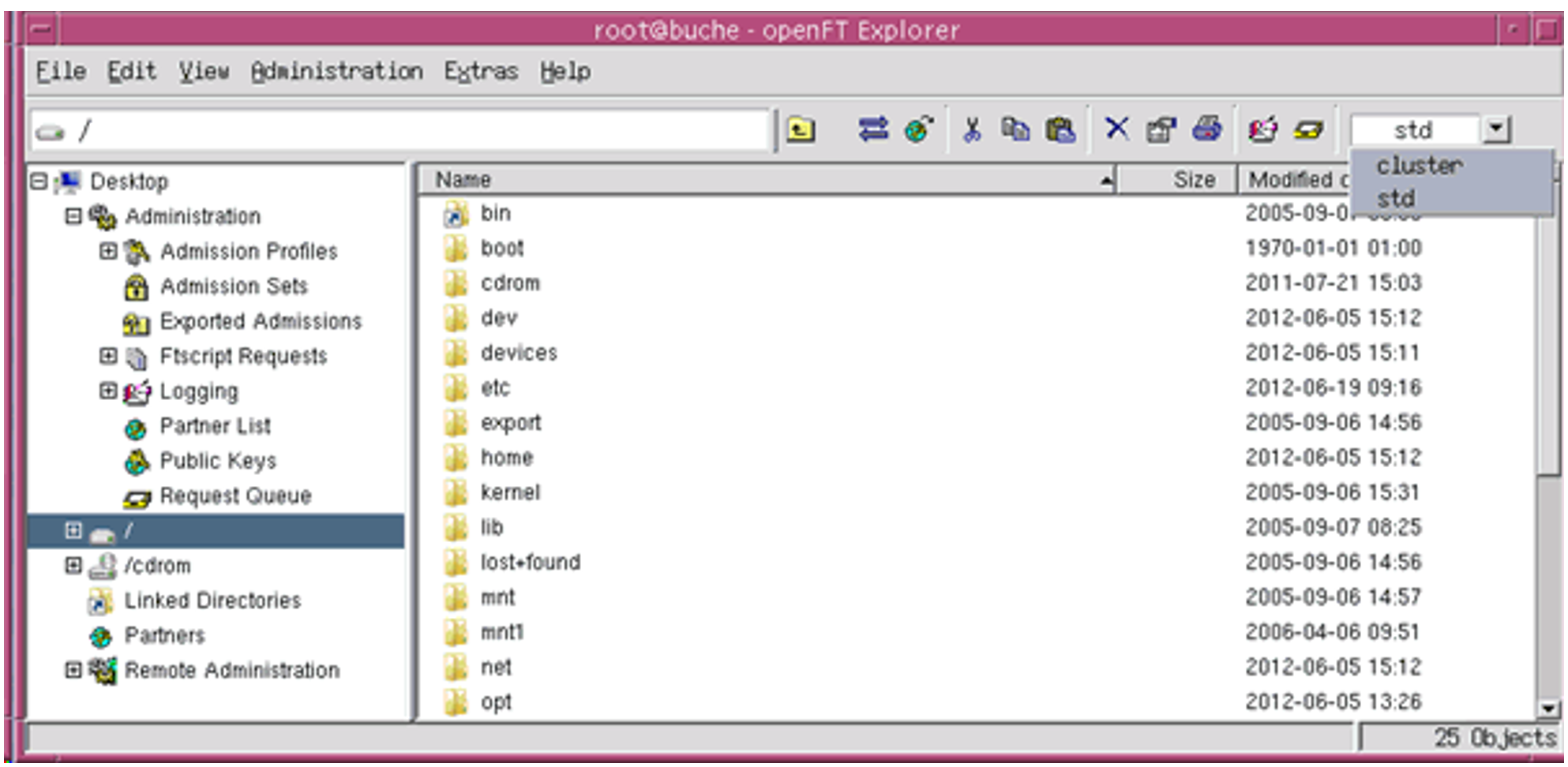The cluster TREE (Unix based systems, IP-address 123.25.10.12) consists of the two computers MAPLE (IP-address 123.25.10.1) and BEECH (IP-address 123.25.10.2). The failure management concept allows TREE to run either on MAPLE or BEECH. Only one openFT instance is fail-safe in this case.
Configure the cluster in such a way that a disk is always available. In this example, it is the directory /openFT.
Required steps for the computer MAPLE
Install openFT (including the add-on products openFT-CR,openFT-FTAM and openFT-FTP, if required)
Deactivate openFT:
ftstopIf you are working with CMX and TNS, you must adapt the $FJAM, $FJAMOUT and $FTAM (if required) TNS inputs to the system. They may only contain RFC1006 and LANINET inputs, see above.
Set the address for the instance std:
ftmodi std -addr=MAPLEThe instance std logs in exclusively at the address MAPLE. All other addresses on the computer are available for other instances.
Activate openFT on the instance std and set the ID, if this did occur automatically during installation:
. ftseti std [ftmodo -id=MAPLE.FOREST.NET] ftstart
Mount the disk /openFT on MAPLE.
Create the new instance cluster and check it. The directory /openFT must exist, whereas the directory /openFT/cluster must not exist:
ftcrei cluster /openFT/cluster -addr=TREE.FOREST.NET ftshwi @a -l Instance Address directory ------- ---------- -------------------- cluster TREE.FOREST.NET /openFT/cluster std MAPLE /var/openFT/std
If authentication is to be used in the instance cluster, then public keys from the partner systems must be stored in the directory /openFT/cluster/syskey, or the public key from the directory /openFT/cluster/config must be made available to the partner systems.
Deactivate the instance cluster:
ftseti std; ftdeli cluster
Required steps on for the computer BEECH
Install openFT (including the add-on products openFT-CR openFT-FTAM and openFT-FTP, if required)
Deactivate openFT:
ftstopIf you are working with CMX and TNS, you must adapt the $FJAM, $FJAMOUT and $FTAM (if required) TNS inputs on the system if they exist. They may only contain RFC1006 and LANINET inputs, see above.
Set the address of the instance std:
ftmodi std -addr=BEECHThe instance std logs in exclusively at the address BEECH. All other addresses on the computer are available for other instances.
Activate openFT on instance std and set the ID, if this did not occur automatically during installation:
. ftseti std [ftmodo -id=BEECH.FOREST.NET] ftstart
Next, make a shell script for administering the instance that handles the Events start, stop, and check. The script must be available and properly configured on the computers MAPLE and BEECH. It might look like the following when RMS (Reliant Monitor Services) is used:
PAR=$1 BIN=/opt/bin; export BIN INST=cluster OPENFTINSTANCE=$INST; export OPENFTINSTANCE case $PAR in start) OPENFTINSTANCE=std; export OPENFTINSTANCE $BIN/ftcrei $INST /openFT/$INST case $? in 0|5) continue;; *) exit 1;; esac OPENFTINSTANCE=$INST; export OPENFTINSTANCE $BIN/ftstart 2>/dev/null case $? in 0|180) exit 0;; *) exit 1;; esac;; stop) $BIN/ftstop 2>/dev/null case $? in0|181) continue;; *) exit 1;; esac OPENFTINSTANCE=std; export OPENFTINSTANCE $BIN/ftdeli cluster case $? in 0) exit 0;; *) exit 1;; esac;; check) VALUE=`$BIN/ftshwo -csv 2>/dev/null |fgrep FtStarted\ |sed s/";"/" "/g` [ -z $VALUE ] && exit 1 set $VALUE i=1 FTROW=1 while [ "$1" != "FtStarted" ] do shift FTROW=`expr $FTROW + 1` done FTSTART=`$BIN/ftshwo -csv|fgrep -v FtStarted|cut \ -f$FTROW -d\;` if [ $FTSTART = '*NO' ] then # openFT server not active exit 1 else # openFT server active exit 0 fi ;; esac
Working with individual instances
When everything is finished, there is a standard instance on both the MAPLE and BEECH computers which is not fail-safe. By making a selection on the openFT Explorer, or by executing the command ftseti std, you will be working with the respective standard instance. You can make use of all the openFT functions in the standard instances (e.g. set up admissions profiles, view log records, etc.). The standard instances on MAPLE and BEECH can be addressed normally from external systems using the addresses of these computers (123.25.10.1 or 123.25.10.2).
The fail-safe instance cluster is available on one of these two computers; the one on which the disk /openFT is currently mounted. You can work with the instance on this computer using the graphical user interface or by using the command
. ftseti cluster and use all of openFT functions available there. It is not necessary to know on
which computer the disk /openFT is mounted during this. You must choose TREE as the partner. The cluster TREE (openFT instance cluster) is addressed externally under the IP address 123.25.10.12.


